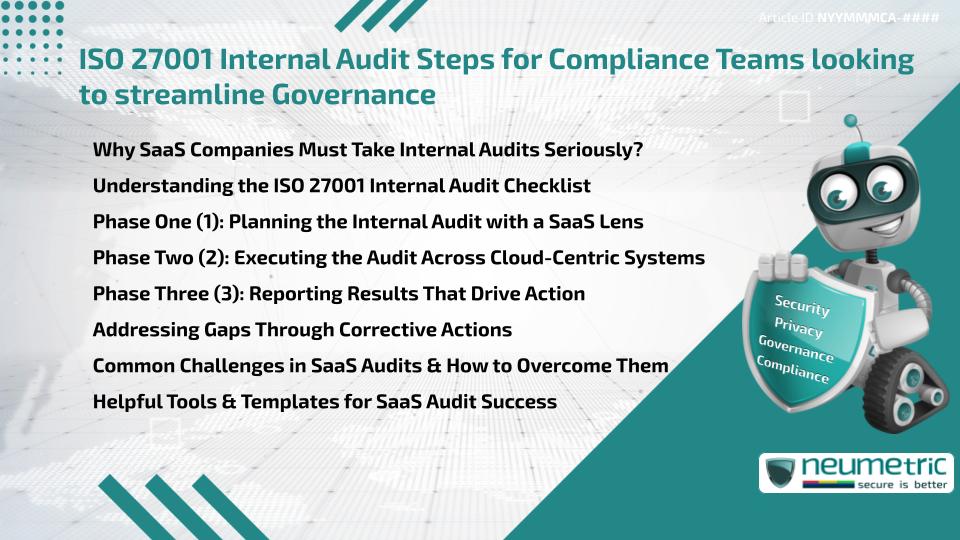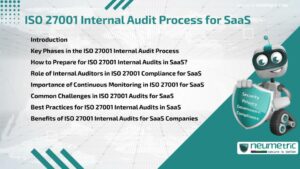Table of Contents
ToggleIntroduction
The path to achieving & maintaining ISO 27001 Compliance begins with understanding & executing robust Internal Audits. For Compliance teams, mastering the ISO 27001 Internal Audit steps for Compliance teams is essential to streamline Governance & ensure accountability. This article simplifies those steps, offers insights from multiple perspectives & prepares you to implement Internal Audits that are both effective & efficient.
What Is an ISO 27001 Internal Audit & Why does It Matter?
An Internal Audit under ISO 27001 is a self-Assessment exercise. It validates whether your Information Security Management System [ISMS] aligns with ISO’s defined controls. Unlike External Audits, Internal Audits are conducted by your own team or an independent Internal party.
Why is it so critical? Because it identifies gaps before an External Auditor does. It ensures your security posture is not just documented but also functional. Most importantly, it reassures Stakeholders that you take Data Protection & Governance seriously.
How Internal Audits Strengthen Governance & Risk Management?
The ISO 27001 Internal Audit steps for Compliance teams help create a feedback loop between policy & operations. They align real-world practices with Governance objectives, enabling Risk-based decision-making. For example, Audit Findings often drive updates in Access Controls, Incident Response procedures & encryption protocols.
Internal Audits also make Governance measurable. By routinely Assessing whether Security Controls are followed, teams can better prioritise remediation, communicate Risk effectively & document due diligence for legal & regulatory obligations.
Planning Phase: Preparing for the Audit with a Clear Scope
Every effective Audit begins with a solid plan. This phase covers:
- Defining Objectives: Are you testing for Compliance, improvement or both?
- Setting Scope: Are you Auditing the entire Information Security Management System [ISMS] or only selected departments?
- Selecting the Audit Team: Independence is key. Avoid Auditing your own processes.
- Creating an Audit Checklist: Base this on Annex A controls & Internal Policies.
Document everything. The Audit plan becomes your reference throughout the process.
Execution Phase: Conducting the Audit with Precision
Once the plan is set, the real work begins. The execution phase involves:
- Opening Meeting: Explain scope & process to Auditees.
- Collecting Evidence: Review documents, system logs & conduct interviews.
- Evaluating Controls: Are controls in place? Are they effective?
- Documenting Observations: Record nonconformities, observations & positives.
Use a Risk-based approach. Focus more on areas with Higher Risk or historical noncompliance.
Reporting Phase: Documenting Findings & Nonconformities
Clarity in reporting is essential. The Audit report should include:
- Executive Summary
- Details of Conformities & Nonconformities
- Impact Assessment
- Recommended Actions
Ensure that each nonconformity references the relevant clause & includes supporting evidence. Share the report with Stakeholders & get formal acknowledgment.
Corrective Actions & Continuous Improvement
The true value of ISO 27001 Internal Audit steps for Compliance teams lies in the Corrective Action process. After identifying a nonconformity:
- Assign an owner
- Investigate root cause
- Propose a Corrective Action
- Implement & monitor
This isn’t a one-off exercise. Each Audit should inform future improvements. Maintain an Audit log to track progress over time.
Common Pitfalls in Internal Audits & How to avoid Them
Even experienced teams stumble. Avoid these mistakes:
- Auditing Without a Clear Scope: Leads to confusion & missed requirements.
- Focusing Only on Documentation: Processes must work in reality too.
- Failure to Involve Stakeholders: Input from process owners is critical.
- Overcomplicating the Audit: Use simple checklists & plain language.
Being aware of these pitfalls is key to mastering ISO 27001 Internal Audit steps for Compliance teams.
Tools & Templates That Help Compliance Teams Audit Better
Many tools can support your Audit process. Look for features like:
- Centralized checklists
- Role-based access
- Audit scheduling
- Nonconformity tracking
You can explore resources like ISACA’s templates, NCUA’s Cybersecurity Assessment tool etc. These make ISO 27001 Internal Audit steps for Compliance teams more efficient & repeatable.
Takeaways
- ISO 27001 Internal Audits are vital for aligning operations with Governance objectives.
- Planning, execution & follow-up are the three pillars of a strong Audit.
- Focus on Continuous Improvement, not just Compliance.
- Use tools to automate where possible.
- Avoid common pitfalls through awareness & documentation.
FAQ
What are the main objectives of an ISO 27001 Internal Audit?
The key objectives are to Assess Compliance with the Information Security Management System [ISMS], verify control effectiveness & identify areas for improvement.
How often should ISO 27001 Internal Audits be performed?
Best practice is at least annually, but High-Risk areas may need more frequent Assessments.
Who can perform an Internal Audit for ISO 27001?
An Internal Auditor must be competent & impartial. It can be someone from another department or an External Consultant.
Do Internal Audit Findings need to be reported to Top Management?
Yes. Management review of Audit results is a core ISO 27001 requirement.
Are Internal Audits mandatory for ISO 27001 Certification?
Yes. Clause 9.2 of the Standard explicitly requires Internal Audits.
Can the same person conduct & review the Audit?
No. Auditors must not Audit their own work. Independence ensures objectivity.
What documents should be reviewed during an ISO 27001 Internal Audit?
Policies, Risk Assessments, access logs, incident reports & previous Audit records.
Is a checklist required for Internal Audits?
While not mandatory, a checklist helps ensure coverage of all ISO 27001 requirements.
How can technology help streamline ISO 27001 Internal Audit steps for Compliance teams?
Tools help automate Audit tasks, track nonconformities & generate reports.
Need help?
Neumetric provides organisations the necessary help to achieve their Cybersecurity, Compliance, Governance, Privacy, Certifications & Pentesting goals.
Organisations & Businesses, specifically those which provide SaaS & AI Solutions, usually need a Cybersecurity Partner for meeting & maintaining the ongoing Security & Privacy needs & requirements of their Clients & Customers.
SOC 2, ISO 27001, ISO 42001, NIST, HIPAA, HECVAT, EU GDPR are some of the Frameworks that are served by Fusion – a centralised, automated, AI-enabled SaaS Solution created & managed by Neumetric.
Reach out to us!





